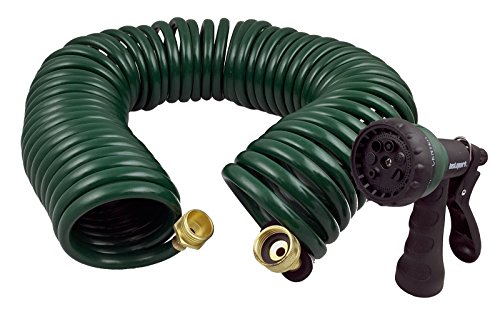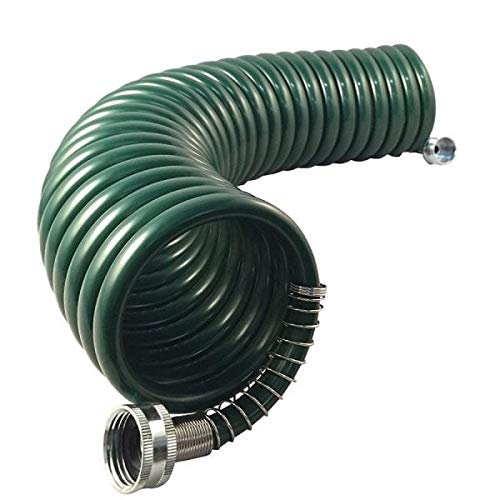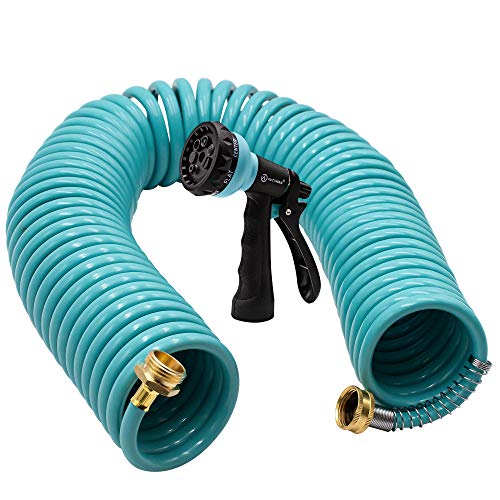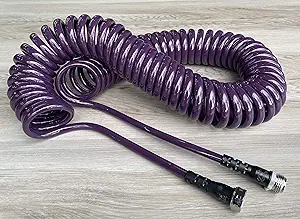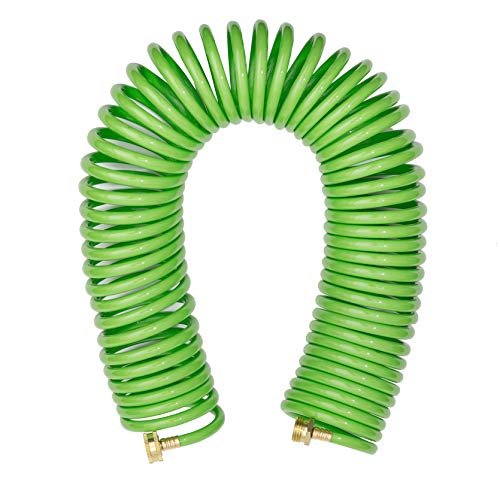Do you have a garden? If so, chances are, you’ve experienced the frustration of dealing with a garden hose. Traditional hoses are bulky, heavy, and tend to break easily. Even the most eager gardeners don’t want to lug around an extremely heavy hose and struggle with random kinks and knots under the sun. At least, not anyone who values their time, right? However, you won’t have to worry about any of these issues again with a coil hose. Unlike other hoses, coil hose comes with a host of features that can solve the problems of kinking, twisting, and fraying. It is undoubtedly a good option for those who want to spend less time winding up and uncoiling their garden hose. That being said, we have put together a list of some of the best coil hoses in 2024, so you can choose the perfect one for your gardening needs. Let’s take a look at some of the year's top options, with the Instapark GHN-06 Coil Hose standing out as our favorite option!
Our Top Picks For Coil Hoses
Buying Guide: Coil Hoses
Selecting the perfect garden hose might seem straightforward, but it actually requires a bit of research. You’ll need to take into account various aspects such as water pressure, hose diameter and length, material quality, and the type of connector. Without expertise, it’s challenging to discern which hose will best suit your garden’s needs. Fear not — this guide is designed to assist you in finding the optimal coil hose for your garden’s unique requirements.
Why Is It Important to Have a Coil Hose?
Almost every gardener knows that working in the garden is excellent for your mental health. But, what about those days when you don’t want to be there? For those days, we have coil hoses! There are so many reasons for investing in a coil hose. Some of them are mentioned below.
- These hoses have excellent resistance to abrasions, chemicals, and UV damage
- They are highly flexible and incredibly efficient for watering small, hard-to-reach plants
- Unlike the traditional hose, this one doesn’t tangle or kink up easily
- You can easily connect it to your tap without worrying about leaks or bursts
- And thanks to their ability to conserve water, they can save you money on your monthly water bill
While coil hoses have several benefits, there is only one drawback. You can’t use them for spraying chemicals on plants as the chemicals can cause damage to the coil of the hose.
Essential Features To Look For While Buying a Coil Hose
It can be challenging to find a suitable hose for your garden. There are a lot of options, and it can be hard to differentiate one product from another. To help you out, here are some factors to keep in mind.
Material
Coil hoses are made up of a coiled length of flexible vinyl tubing with an internal plastic liner. The vinyl tubing provides the strength that allows the hose to withstand pressure and resist kinking, whereas the liner protects the interior components from abrasion. Some hoses are typically made of PVC, which breaks down in the sun, so look for flexible and UV-resistant hoses.
Also, make sure you choose hoses made from lightweight materials since heavy ones can be much harder to carry around.
Type of connectors
Some coil hoses come with plastic or metal connectors for attaching to your existing garden hose. Make sure the hose is compatible with your system for easy fitting and proper operation.
Kink resistance
When it comes to hoses, you probably want to buy one that doesn’t kink easily. Kinking occurs when the hose twists itself into a tight coil, causing it to lose its shape. This makes it hard to water plants or irrigate crops such as squash, cucumbers, or tomatoes without causing damage to them or the soil. You should look for hoses that are resistant to kinking and twisting.
Hose diameter
Coil hoses come in a range of diameters, ranging from 3/8 inch (roughly 1 cm) to 1-1/2 inch (approximately 3 cm). The larger the diameter, the larger the hose. But these hoses are more expensive. Make sure to get the coil hose with a large diameter which makes it easier to move water.
Hose length
Another critical factor that affects your garden hose choice is length. Hoses come in different length ranges, with the most common being 50 feet, 75 feet, 100 feet, and 150 feet. Shorter hoses are useful for gardens under 50 feet, while longer ones are useful for over 100 feet. Hoses over 100 feet tend to kink more easily and can break if subjected to too much force. Check the size of the garden and buy the hose accordingly.
Water pressure
A pressure rating indicates how much pressure a hose can withstand before leaking. The higher the pressure rating, the more chances it has of bursting underwater pressure. The maximum pressure is typically between 40 and 60 PSI (which would allow you to water plants at a rate of about 1/4 to 1/2 gallon per minute).
The water pressure in your municipality can vary widely, so it’s wise to get an accurate idea of how much pressure you have before buying a coil hose. Make sure that your coil hose can handle that pressure without bursting.
Price Range
Coil hoses are a worthwhile investment for any gardener. They come in many different materials and sizes and typically cost around $15 to $60. The least expensive coil hoses are made of rubber and feature metal fittings. They are suitable for most outdoor chores and can be purchased for less than $20.
Tips To Maintain a Coil Hose
A coiled hose is a handy gardening accessory. Here are some tips you should follow to maintain your hose.
- Rinse the coil hose with clean water after every use, but do not use soap or detergent on the hose itself
- Coil hoses are flexible, but they should not be overstretched since overstretching the hose can damage it or kink it
- Do not tie the hose together using a string or wire
- Inspect the hose regularly for signs of wear or holes, and if you notice rust developing or spot any leaks, replace it immediately
- Coil hoses are vulnerable to gnawing attacks by rodents, so place them inside your garage or shed whenever it’s not in use
If you buy a new coil hose, let it dry out completely before you try to attach it to a spigot. Coil hoses don’t have a built-in water-tightness system, so you need to apply some pressure to the faucet before turning on the water. If you don’t do this, the water that comes out of the hose could be contaminated, or it could freeze, leading to a cracked hose.
To learn how to properly store your coil hose, watch this video from Mity Mouse:
People Also Asked
What's the difference between coiled hoses and flat hoses?
Coiled hoses have a spiral design and are often used in garden applications. In contrast, flat hoses are longer and broader than coiled hoses and are often used in industrial applications.
How do I store my coil hose?
Always store coil hoses upright. Coil hoses aren't designed to lay flat and can lead to kinks or leaks. You'll want to keep the hoses away from sources of heat, such as sunlight or heaters, to prevent cracking or melting.
How can I stop my coil hose from corroding?
Some coil hoses erode over time. Periodically, you should wipe down the coils with a cloth dipped in white vinegar. This treatment can help keep yours from rusting.
What are the benefits of coil hoses?
Coiled garden hoses shrink to a third of their size for space-saving storage and are light enough to carry without strain. Their no-kink design and memory system prevent tangling, ensuring they lay flat during use and recoil effortlessly. These hoses are also durable against wear and UV damage, and efficiently water hard-to-reach plants.
When should I replace my coil hose?
Knowing when to replace your coil hose is crucial for efficient watering. Look for visible cracks, bulges, leaks, or any soft areas as they indicate it's time for a new one. Regular maintenance and proper storage can extend its life.




